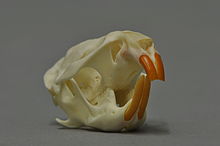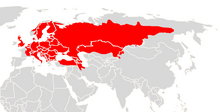Eastern water vole
| Eastern water vole | ||||||||||||
|---|---|---|---|---|---|---|---|---|---|---|---|---|

Eastern water vole |
||||||||||||
| Systematics | ||||||||||||
|
||||||||||||
| Scientific name | ||||||||||||
| Arvicola amphibius | ||||||||||||
| ( Linnaeus , 1758) |
The Eastern water vole , also short water vole or large vole ( Arvicola amphibius , Syn .: Arvicola terrestris ) is a species of mammals from the subfamily of voles (Arvicolinae). The range of the species covers large parts of the Palearctic and ranges from Great Britain to the Lena in Siberia . The water vole shows predominantly aquatic as well as terrestrial populations as well as transitional forms. The species is considered harmless.
Mark
Eastern water voles are large, stocky and long-tailed voles. The Eastern water vole is the second largest vole species in Europe after the naturalized muskrat , although the aquatic animals are significantly larger and heavier than the terrestrial ones. The head-torso length in aquatic populations is 130-240 mm, the tail length 100-146 mm, the length of the hind foot 28-35 mm and the ear length 15-20 mm. The animals weigh 130-320 g. Terrestrial water voles, on the other hand, only reach a head-trunk length of 130-165 mm, a tail length 50-90 mm, the length of the hind foot is 22-27 mm and the ear length 12-15 mm. These animals weigh 65-130 g.
The fur is long, dense and shiny. It is variable on the upper side, mostly dark brown, more rarely light brown and often black, especially in aquatic populations in lowlands. The tail is lighter. The underside is whitish or yellowish gray.
distribution and habitat
The eastern water vole inhabits large parts of the Palearctic . The distribution area extends in west-east direction from Great Britain and northwestern Spain to the Lena and Lake Baikal in Siberia . In north-south direction, the area in Europe extends from the northern tip of Norway to the north of Portugal , to the southern tip of Italy and to the north of Greece ; further east with individual foothills to the north-west of Iran and to the south-east of Kazakhstan .
Depending on the population, the animals live mainly aquatic on rivers, streams and in swamps or terrestrially in meadows, in orchards and gardens, less often in wooded areas. However, these two “ecotypes” are not clearly separated. Aquatic populations occur from sea level up to 3200 m altitude, terrestrial populations predominantly live in mountains up to 2500 m altitude.
Systematics
The systematics of the Eastern water vole has long been a controversial issue. At least 36 subspecies have been described for the species. After investigations of the mitochondrial DNA , however, these subspecies can be grouped into three forms that do not exactly correspond to the above-mentioned ecotypes and for each of which the survey of separate species is also being discussed:
- Arvicola amphibius amphibius ; Largest part of the distribution area, living aquatic with transitions to the terrestrial way of life.
- Arvicola a. sherman ; Form restricted to mountains in the southwest of the area in the Carpathians , the Alps, in the Massif Central , in the Pyrenees and in the north of the Iberian Peninsula , living terrestrially. According to Wilson and Reeder, the area of this form also extends to Belgium and the south of the Netherlands .
- Arvicola a. italicus ; Italy south of the Alps, aquatic life with transitions to the terrestrial way of life.
Way of life
Eastern water voles are nocturnal and crepuscular, less often diurnal. Aquatic animals swim and dive well and use all four legs to move. The widely ramified buildings with nests and storage rooms are built in densely overgrown bank slopes, the entrances are both below and above the water surface. In damp areas, the nest is built above ground, for example on sedge bulbs or free-swimming when the water level is high .
The duct systems of terrestrial populations that run flat under the earth's surface are similar to those of the mole . When piles of earth are thrown up, however, they are flatter and less stable than with the mole. The predominantly plant-based diet consists of aquatic plants in aquatic populations, and primarily roots, bulbs and tubers in terrestrial populations. Occasionally the animals will eat mollusks , insects and small fish.
Reproduction
Reproduction takes place from March to October, the number of litters per year is 3 to 5. The gestation period is about 22 days. The litters are relatively large; they include 2–9, exceptionally up to 14 young, but mostly 4–6 young. The freshly born young mice weigh 3.2–7.8 g, depending on the litter size. The eyes open at 8–11 days of age, with an average of 9 days; the young are sexually mature at around 60 days. The lifespan in captivity was a maximum of 3.5 years.
Damage
The animals can cause economically relevant damage primarily by eating their roots in orchards and tree nurseries, as well as in vegetable crops, especially carrots and asparagus . In North Macedonia, significant damage was also recorded in rice fields at high densities .
Combat
Voles are combated by means of fumigants , poison baits , vole reject devices or mousetraps . In larger plantations, poison baits are used with a vole plow to make work easier .
Existence and endangerment
Even in optimal habitats, the species rarely reaches densities higher than 100 individuals per hectare . In Scandinavia and the Baltic States , similar to other voles, there are strong cyclical fluctuations in the population.
In parts of western and southern Europe, e.g. In the United Kingdom, the Netherlands and Italy, for example, there have been significant decreases in aquatic populations. The causes are considered to be habitat destruction, water pollution , predation by the introduced mink and competition with the muskrat, which was also introduced . Locally and regionally, populations have been drastically reduced or wiped out by the drainage of wetlands, especially in Israel, Turkey and Georgia. In many areas of the range, however, water voles are common and populations are stable, and in northern central Europe the species is sometimes considered a pest. According to the IUCN, the world population is considered safe ( least concern ), and in Germany, too, the Eastern water vole is listed as safe in the Red List .
literature
- Stéphane Aulagnier, Patrick Haffner, Anthony J. Mitchell-Jones, François Moutou, Jan Zima: The mammals of Europe, North Africa and the Middle East. The destination guide. Haupt, Bern et al. 2009, ISBN 978-3-258-07506-8 , pp. 196-197.
- Anthony J. Mitchell-Jones, Giovanni Amori, Wieslaw Bogdanowicz, Boris Krystufek, PJH Reijnders, Friederike Spitzenberger, Michael Stubbe, Johan BM Thissen, Vladimiŕ Vohralik, Jan Zima: The Atlas of European Mammals. Poyser, London, 1999, ISBN 0-85661-130-1 , pp. 222-223.
- Erwin Stresemann (founder), Konrad Senglaub (ed.): Excursion fauna of Germany. Volume 3: Vertebrates. 12th, heavily edited edition. G. Fischer, Jena et al. 1995, ISBN 3-334-60951-0 , p. 422.
Individual evidence
- ^ The Ostschermaus on the Red List of the IUCN, distribution map
- ^ S. Aulagnier, P. Haffner, AJ Mitchell-Jones, F. Moutou, J. Zima: The mammals of Europe, North Africa and the Middle East. The destination guide. Haupt, Bern et al. 2009, p. 196.
- ↑ Don E. Wilson , DeeAnn M. Reeder (Ed.): Mammal Species of the World. A taxonomic and geographic Reference. 2 volumes. 3. Edition. Johns Hopkins University Press, Baltimore MD 2005, ISBN 0-8018-8221-4 , online .
Web links
- Arvicola amphibius in the endangered Red List species the IUCN 2008. Posted by: Batsaikhan, N., Henttonen, H., Meinig, H., Shenbrot, G., Bukhnikashvili, A., Amori, G., Hutterer, R., Kryštufek, B., Yigit, N., Mitsain, G. & Palomo, LJ, 2008. Retrieved December 22, 2009.
- Distinguishing features of water vole and mole


